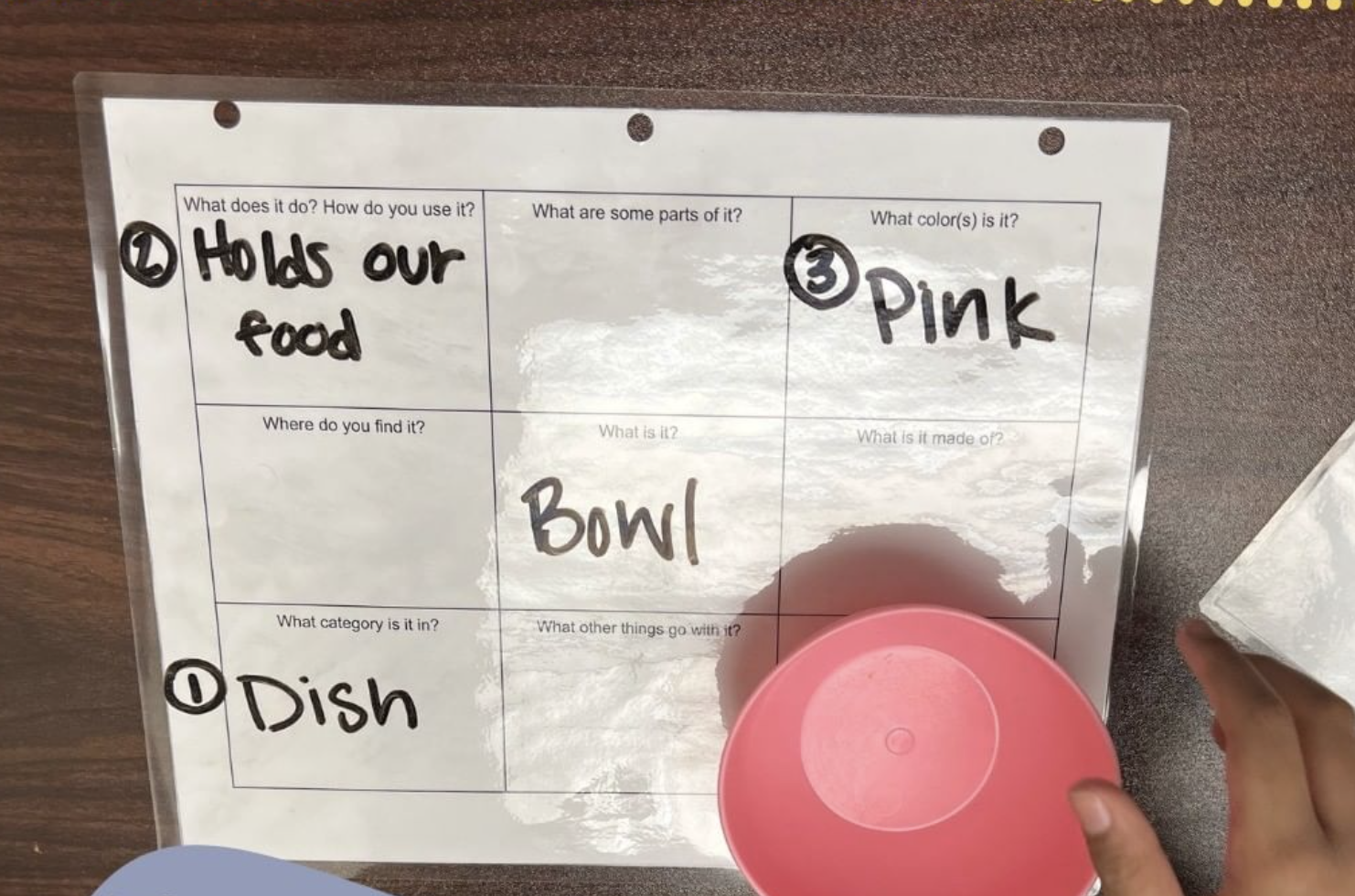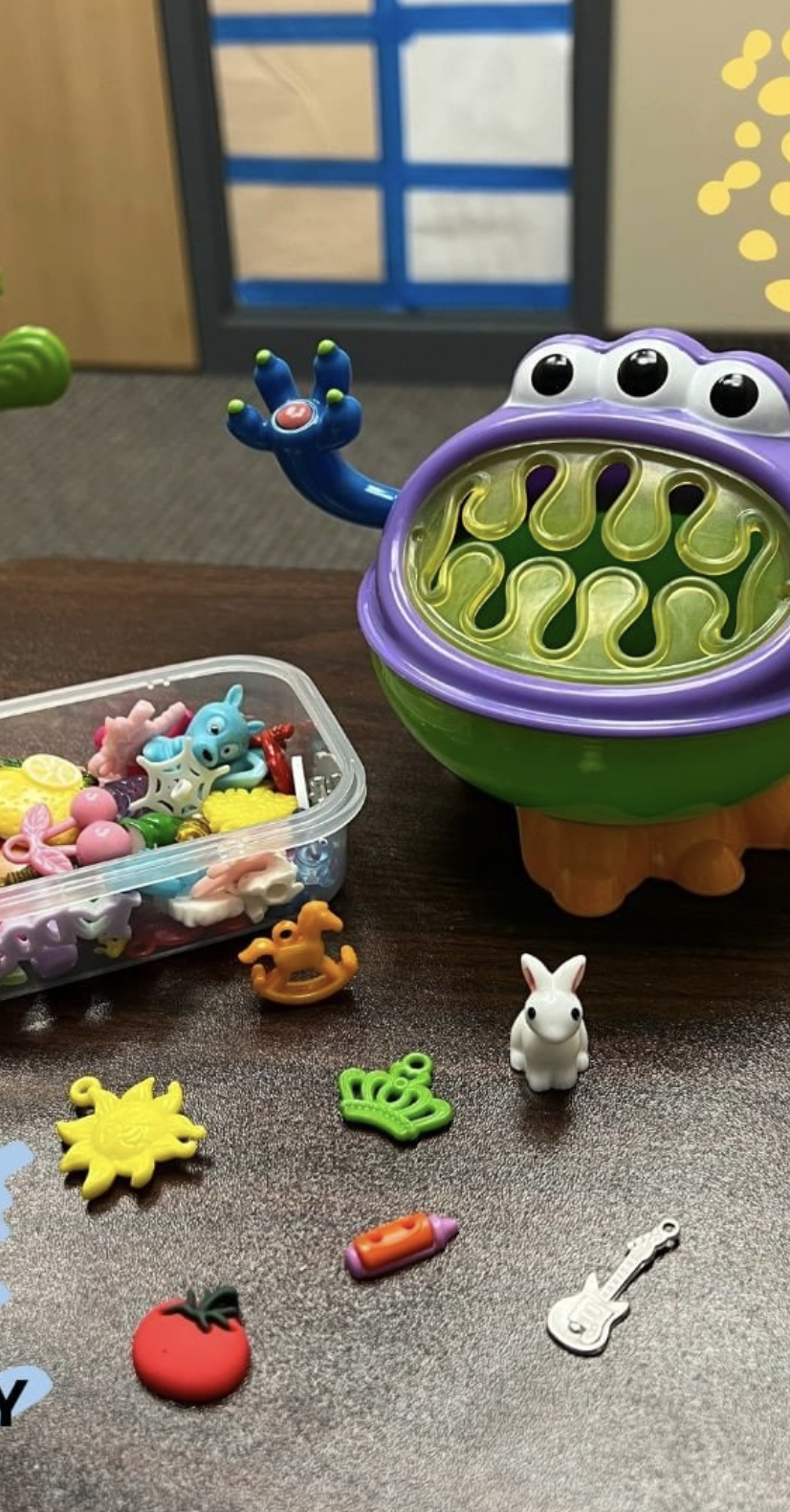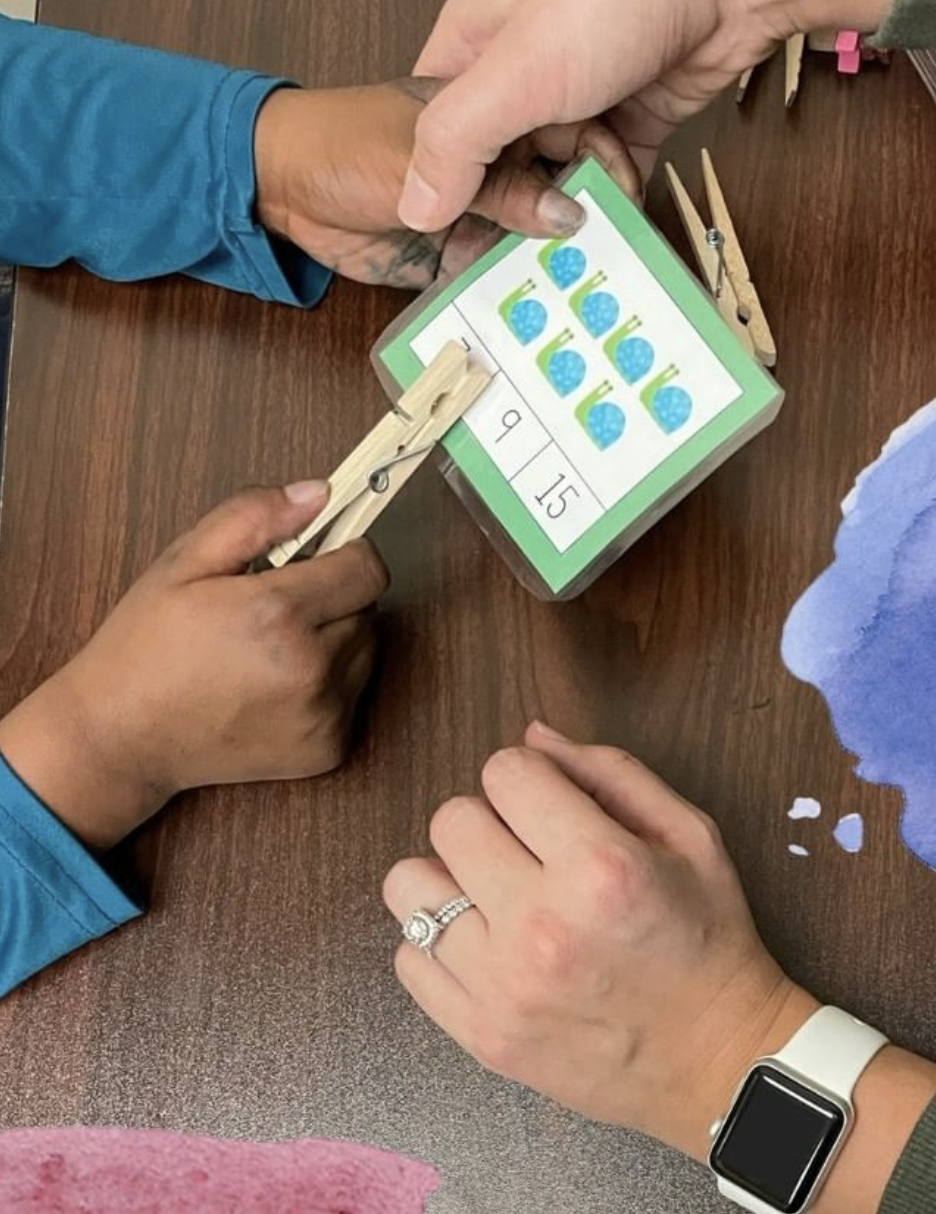Therapy Toys, Games, and Activities For Your kids!
Here’s a look into some of our favorite therapy toys, activities, skills, and games surrounding Occupational and Speech Therapy.
Puzzles
Puzzles as a tabletop activity are great for sequencing, concentration, organization, fine motor skills and problem solving. Puzzles can be progressed from a table activity to the floor, with the child in a quadruped position, where both hands and knees are on the ground. This position allows your child to work on:
Core strength
Upper arm weight bearing
Balance
Weight shifting
Reaching
Try a floor puzzle in the quadruped position to see many of these benefits! Today we added in a matching aspect, where Theo had to find the block letter that matched the correct part of the puzzle.
Describing Everyday Objects
At Olea Pediatric Therapy, some of our kiddos are working on expanding their language by describing everyday functional objects. Our kiddos pick a mystery item out of our toy bin, and then are asked to share three characteristics about their object utilizing various attributes such as category, function, size/shape/color, parts, composition, and associations. We use our “describing chart” as a visual aid to support us when we were stumped, and encourage us to consider all the different ways in which we can describe! By practicing our describing skills, we are building a solid foundation for higher-level language abilities such as categorizing, comparing and contrasting; which are necessary life skills we use every day!
Mini Objects
Let’s talk about mini objects! To our speech therapists at Olea Pediatric Therapy, mini objects are like books - they offer limitless possibilities for how they can be used during therapy. Here are a few ways in which we use mini objects to target your kiddo’s speech + language goals:
COMPARE/CONTRAST: Choose a few mini objects and take note of similarities and differences such as size, color, shape, function, location, etc. This is an excellent opportunity to work on expanding utterances with carrier phrases like, “A apple is different than a carrot because…”
CATEGORIES: We can sort them according to predetermined category titles such as: transportation, animals, food items, household items, toys, colors, size, etc.
SPATIAL CONCEPTS/PREPOSITIONS: Place mini objects around your environment and describe the location they are in using concepts such as “beside”, “between”, “behind”, “in front of”, “next to”, “under”, “over”, etc.
FOLLOWING DIRECTIONS: Have your kiddo follow simple one-step directions or multi-step directions. “Place the cat on the top shelf.” “After you put the button on the chair, put the pumpkin on the table.” Working on multi-step directions can also target SEQUENTIAL CONCEPTS such as “first”, “next”, “last”, etc.
This week, we used mini objects to target our articulation goals by playing “I Spy” to find objects that began with the /r/ sound! Can you figure out how each of these objects we picked out correlate with a word that begins with an /r/ sound?
Trains
All aboard the speech train! Playing with toy trains provides amazing opportunities for our speech therapy kiddos because it is an open ended toy, and can be easily modified to target their articulation, speech and language goals. One of the first forms of communication that we develop is joint attention or shared focus on an object/activity, and using toy trains allow us to target that skill in a fun play-based way. We can also expand our functional vocabulary by using a variety of action words, adjectives, nouns and prepositions including colors, numbers, and words like “go”, “stop”, “on”, “off”, “up”, “down”,“fast”, and “slow”. You can target following directions by giving basic one-step directions (“give me the train”) or more complex directions (“put the blue train car in the front and the red behind it.”). With our trains, we can encourage expansion of utterances as well; for example, if the child says “train”, you can model “go train” or “green train” or “I see train” to encourage use of longer and more complex statements during play. So put on your conductor hat and keep chuggin’ on your language!
Squigs
A great activity to help your child prepare for tricky fine motor tasks and handwriting, while having fun, is Squigs on a window or mirror. Vertical surfaces provide upper body and shoulder girdle strengthening as your child works against gravity to place and pull off the Squigs. You can increase the challenge by adjusting their position as well; have them stand on a bosu ball or soft surface, take a tall kneel, or half knee position as they play. Place the container of Squigs on their non-dominant side to encourage crossing midline, and maybe turn their masterpiece into a maze by dropping a small ball from the top and watching it fall down the surface, weaving in and out of the Squigs!
Sensory Bins
Let's talk about sensory bins! Not only are they fun and interactive, but they are for our students who need increased sensory input. Sensory activities help with self-regulation, improving focus, reducing distractions, and building neural connections to learn and retain information. Sensory stimulation is critical to the development of our brains and when we are using more than one sense, we will learn and retain more information! Below are a few of the speech + language areas we can target with sensory bins:
Practicing simple verbs (open, close, find, feel, etc.)
Joint attention
Sorting objects into categories
Vocabulary
Imitating actions (shaking, scooping, etc.)
Following directions
And more!
Sensory bins also provide a great opportunity to collaborate and co-treat with our occupational therapists to help our kiddos meet their occupational goals. Sensory bins are simple to make and we chose to fill ours with rice and kidney beans. Swipe right for some ideas on what you can use to fill your own bins at home!
Fishing
Let’s go fishing! This activity involves using our super awesome Melissa and Doug magnetic fishing set to target our speech therapy goals. We have used our fishing set to work on describing, sentence expansion, asking for help, and targeting our speech sounds in a fun and active way, to name a few! Fishing also provides a great opportunity to incorporate co-treatment into our sessions as this activity targets occupational therapy goals such as hand-eye coordination, visual scanning, as well as upper extremity strengthening and range of motion!
Beading
Beading is a great fine motor activity that works on using your smaller hand muscles to promote a pincer tripod and grasp. We love using beads because it can also promote:
In hand manipulation skills needed to turn and adjust the bead prior to putting the string through the hole
Bilateral hand skills needed to use both hands to work together
Visual scanning skills needed to scan all the beads in a busy visual field to find the one you are searching for
Sequencing and direction following skills needed to follow along to the example card
Planning skills and more!
Beading is an inexpensive and effective activity used to make progress towards our fine motor developmental milestones!
Counting, clothes pins, and matching!
We’ve been targeting our lateral grasp, and bilateral coordination needed to hold the paper + clothespin, motor planning, counting and matching skills with this activity. Improving this grasp increases our independence with using a key to open a door, open tupperware containers, and more! What other activities use this grasp?!
Scooter Boards
You can do so many fun things by incorporating a scooter-board into activities. Have your child lay prone (on belly) on the scooter-board and propel themselves forward by using their arms and hands. Set up a puzzle across the room and have them navigate around the room to retrieve each piece and bring them back to the puzzle to put them into the correct spots. Keep going until the puzzle is complete! This is a great strengthening activity for the core, shoulders and arms/hands; and this targets bilateral coordination by making both arms push off at the same time. This is also a fun activity for our sensory seeking kiddos to help organize and regulate their bodies.
Pictures
Our speech therapists at Olea Pediatric Therapy love using picture scenes to target our clients' speech + language goals because they are engaging and versatile. Utilizing picture scenes during treatment sessions is an easy, low-prep way to target any of the following areas:
Conversational turn-taking
Initiating conversations
Vocabulary
WH questions
Sentence formulation
Identifying nouns and pronouns
Making inferences, and so much more!
Here are some examples of scenes we have used in therapy this week, and see what goal areas you can target at home!
Swings
The smooth back and forth motion of a swing can be a calming source of movement for children with sensory processing difficulties. When we spin in circular movements this can be alerting. Swinging helps neutralize disruptions caused by the vestibular system, and impacts the brain’s ability to process sensory information.
Play Kitchens
Utilizing play food and a kitchen set is a great way to target our speech+language goals during play! In addition to expanding our functional vocabulary, play kitchens provide us with endless therapy opportunities:
Color identification (see our video!)
Categorization (fruits, veggies, meat, etc.)
Verbs (cook, bake, stir, roll, cut, etc.)
Object function (What do we use to cut our food? A knife!)
Following directions with basic concepts (“Put the milk IN the refrigerator”, “Cook the eggs ON the stove”)
Wh- questions (“WHO is cooking?”, “WHERE do we cook food”?)
The best part about play kitchens is that it prepares our little ones for navigating their own real-life kitchens once they are big enough! We love establishing this solid foundation as we target our functional goals.
Snowflake Making
This activity targeted bilateral coordination to hold scissors and coffee filters at the same time, intrinsic hand strength required to open and close scissors, and hand eye coordination to align snips (to name a few).
Looking for more toys, activities, skills, and games surrounding Occupational and Speech Therapy?
Follow us on social media where we post ideas weekly!














